This is an AI Free Zone! Text created by Large Language Models is spreading rapidly across the Internet. It's well-written, artificial, frequently inaccurate. If you find a mistake on Spaceweather.com, rest assured it was made by a real human being. | | |
GEOMAGNETIC STORM WATCH (G2): NOAA has issued a geomagnetic storm watch for Aug. 3rd, when a CME is expected to graze Earth's magnetic field. Hurled into space by an M8-class solar flare, the CME could spark a G2-class geomagnetic storm with naked-eye auroras in northern-tier US states. CME Impact alerts: SMS Text
SUNSPOT COUNTS HIT A 23-YEAR HIGH: The sun is partying like it's 2001. That's the last time sunspot counts were as high as they are now. The monthly average sunspot number for July 2024 was 196.5, according to the Royal Observatory of Belgium's Solar Influences Data Analysis Center. This eclipses every month since Dec. 2001:
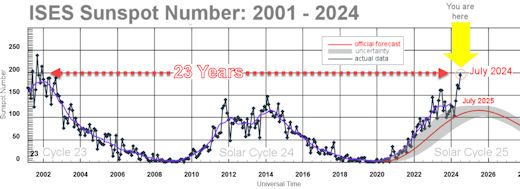
Solar Cycle 25 wasn't expected to be this strong. When it began in Dec. 2019, experts predicted it would be a weak cycle like its immediate predecessor Solar Cycle 24. If that forecast had panned out, Solar Cycle 25 would be one of the weakest solar cycles in a century.
Instead, Solar Cycle 25 has shot past Solar Cycle 24 and may be on pace to rival some of the stronger cycles of the 20th century. Already in May 2024 we have experienced a century-class geomagnetic storm with auroras sighted in the South Pacific, central America and south Africa.
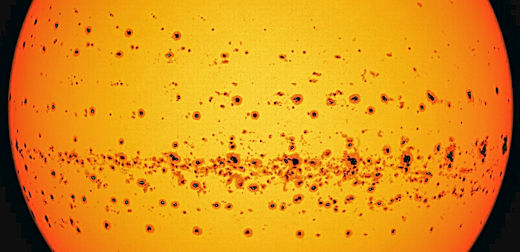
Above: A composite image of sunspots in July 2024. credit: Senol Sanli
The last time sunspot numbers were this high, the sun was on the verge of launching the Great Halloween Storms of 2003, which included the strongest X-ray solar flare ever recorded (X45) and a CME so powerful it was ultimately detected by the Voyager spacecraft at the edge of the solar system.
Is this Solar Max? The jury is still out. Sunspot numbers may continue to rise in the months ahead and, based on the behavior of previous cycles, we can confidently expect high solar activity for at least 2 to 3 more years. Stay tuned! Solar flare alerts: SMS Text
AURORAS IN THE USA: A Cannibal CME hit Earth on July 30th, followed by two lesser CMEs on July 31st. None of the impacts was strong, but together they sparked photographic auroras in more than a dozen US states. Terrence Cook was driving down I-80 near Billings, Montana, when the light show began:
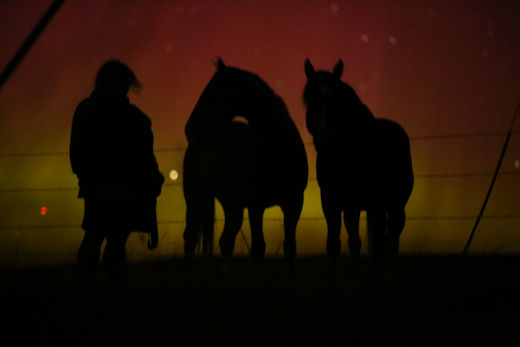
"I pulled over to enjoy the show, and during the brightest lights of the night, two horses visited us from the dark," says Cook. "They even seemed to be aware of it, although much more interested in us."
Similar auroras could appear on Aug. 3rd when a potent CME is expected to graze Earth's magnetic field. The off-target CME *might* miss, but if it doesn't, G2-storms are likely. Aurora alerts: SMS Text
Realtime Aurora Photo Gallery
Free: Spaceweather.com Newsletter
SILK SPACE ROSE: This rose will last forever, and it has been to the edge of space. On Jan. 4th, the students of Earth to Sky Calculus launched it onboard a cosmic ray research balloon. At the apex of the flight it floated 111,424 feet above the Sierra Nevada mountains of central California:
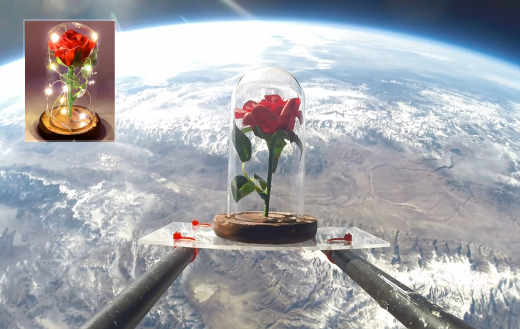
You can have it for $126.65. The students are selling space roses to support their cosmic ray ballooning program. Each silk bloom comes with a greeting card showing the rose in flight and telling the story of its journey to the stratosphere and back again. Also included are the glass dome, wooden base, and an LED light kit to make your rose glisten like the stars.
Far Out Gifts: Earth to Sky Store
All sales support hands-on STEM education
Realtime Space Weather Photo Gallery
Free: Spaceweather.com Newsletter
Realtime Comet Photo Gallery
Free: Spaceweather.com Newsletter
Realtime Noctilucent Cloud Photo Gallery
Free: Spaceweather.com Newsletter
Every night, a network of
NASA all-sky cameras scans the skies above the United States for meteoritic fireballs. Automated software maintained by NASA's Meteoroid Environment Office calculates their orbits, velocity, penetration depth in Earth's atmosphere and many other characteristics. Daily results are presented here on Spaceweather.com.
On Aug 02, 2024, the network reported 38 fireballs.
(24 sporadics, 8 Perseids, 3 southern Delta Aquariids, 3 alpha Capricornids)
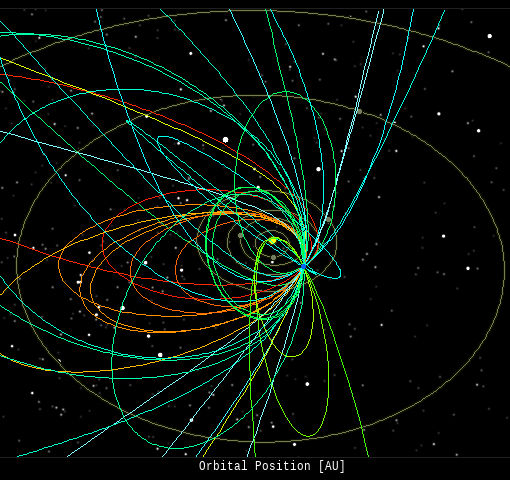
In this diagram of the inner solar system, all of the fireball orbits intersect at a single point--Earth. The orbits are color-coded by velocity, from slow (red) to fast (blue). [Larger image] [movies]
Potentially Hazardous Asteroids (
PHAs) are space rocks larger than approximately 100m that can come closer to Earth than 0.05 AU. None of the known PHAs is on a collision course with our planet, although astronomers are finding
new ones all the time.
On August 2, 2024 there were 2349 potentially hazardous asteroids.
 |
Recent & Upcoming Earth-asteroid encounters: | Asteroid | Date(UT) | Miss Distance | Velocity (km/s) | Diameter (m) |
| 2024 NZ1 | 2024-Jul-28 | 19.5 LD | 12.7 | 56 |
| 523664 | 2024-Jul-28 | 14.9 LD | 23.7 | 680 |
| 2024 OE2 | 2024-Jul-28 | 6 LD | 8.8 | 13 |
| 2024 OK | 2024-Jul-28 | 6.9 LD | 4.6 | 12 |
| 2024 OH | 2024-Jul-29 | 19.2 LD | 12.6 | 41 |
| 2024 OO1 | 2024-Jul-29 | 14.4 LD | 10 | 43 |
| 2024 OF | 2024-Jul-29 | 18.7 LD | 10.1 | 66 |
| 2024 OB1 | 2024-Jul-29 | 14.8 LD | 9.1 | 32 |
| 2024 OS1 | 2024-Jul-30 | 12 LD | 14.1 | 45 |
| 2024 OT1 | 2024-Jul-30 | 2.2 LD | 14.6 | 17 |
| 2024 OO | 2024-Aug-01 | 5.2 LD | 11.3 | 28 |
| 2024 OE | 2024-Aug-01 | 3.9 LD | 9.3 | 61 |
| 2024 NS1 | 2024-Aug-02 | 5.3 LD | 7.6 | 45 |
| 2020 PN1 | 2024-Aug-02 | 18 LD | 5.5 | 29 |
| 2024 OJ2 | 2024-Aug-03 | 18.7 LD | 10.4 | 36 |
| 2024 OC | 2024-Aug-04 | 19.4 LD | 10 | 132 |
| 2023 HB7 | 2024-Aug-05 | 14.7 LD | 6.1 | 32 |
| 2017 TU1 | 2024-Aug-05 | 10.1 LD | 10.1 | 22 |
| 2024 OF2 | 2024-Aug-06 | 10.3 LD | 12.1 | 45 |
| 2024 OR1 | 2024-Aug-06 | 8.9 LD | 8.4 | 35 |
| 2024 OM1 | 2024-Aug-06 | 3.7 LD | 12.2 | 50 |
| 2024 KH3 | 2024-Aug-10 | 14.6 LD | 11.4 | 190 |
| 2024 ON2 | 2024-Aug-12 | 17.8 LD | 14.1 | 36 |
| 2024 OS | 2024-Aug-13 | 20 LD | 7 | 28 |
| 2024 OB2 | 2024-Aug-14 | 19.9 LD | 19.4 | 71 |
| 2021 GY1 | 2024-Aug-16 | 17.7 LD | 6.3 | 59 |
| 2024 JV33 | 2024-Aug-19 | 12 LD | 11.1 | 205 |
| 2022 BF2 | 2024-Aug-19 | 19.7 LD | 16.4 | 91 |
| 2020 RL | 2024-Aug-27 | 12.2 LD | 8.2 | 34 |
| 2021 RA10 | 2024-Aug-28 | 6.8 LD | 4.9 | 29 |
| 2012 SX49 | 2024-Aug-29 | 11.2 LD | 4.3 | 20 |
| 2016 RJ20 | 2024-Aug-30 | 18.3 LD | 14.8 | 68 |
| 2021 JT | 2024-Sep-01 | 16.4 LD | 8.2 | 12 |
| 2021 RB16 | 2024-Sep-02 | 12.3 LD | 8.4 | 15 |
| 2007 RX8 | 2024-Sep-02 | 18.5 LD | 7 | 44 |
| 2022 SR | 2024-Sep-07 | 9.1 LD | 6.3 | 42 |
| 2023 SP2 | 2024-Sep-09 | 15.3 LD | 4.2 | 8 |
| 2016 TU19 | 2024-Sep-11 | 13.2 LD | 10.1 | 47 |
| 2019 DJ1 | 2024-Sep-15 | 10.4 LD | 4.9 | 15 |
| 2024 ON | 2024-Sep-17 | 2.6 LD | 8.9 | 312 |
| 2013 FW13 | 2024-Sep-18 | 8.5 LD | 15.6 | 162 |
| 2022 SW3 | 2024-Sep-19 | 6.8 LD | 9.2 | 37 |
| 2015 SH | 2024-Sep-19 | 11.6 LD | 5.9 | 9 |
| 2023 RX1 | 2024-Sep-20 | 10.1 LD | 1.1 | 3 |
| 2018 VG | 2024-Sep-20 | 13.4 LD | 7.3 | 12 |
| 2020 GE | 2024-Sep-24 | 1.7 LD | 2.2 | 8 |
| 2011 ST12 | 2024-Sep-27 | 17.6 LD | 7.4 | 19 |
Notes: LD means "Lunar Distance." 1 LD = 384,401 km, the distance between Earth and the Moon. 1 LD also equals 0.00256 AU. | | Cosmic Rays in the Atmosphere |
SPACE WEATHER BALLOON DATA: Almost once a week, Spaceweather.com and the students of Earth to Sky Calculus fly space weather balloons to the stratosphere over California. These balloons are equipped with sensors that detect secondary cosmic rays, a form of radiation from space that can penetrate all the way down to Earth's surface. Our monitoring program has been underway without interruption for 7 years, resulting in a unique dataset of in situ atmospheric measurements.
Latest results (July 2022): Atmospheric radiation is decreasing in 2022. Our latest measurements in July 2022 registered a 6-year low:
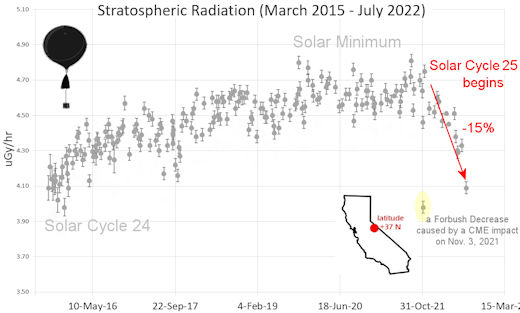
What's going on? Ironically, the radiation drop is caused by increasing solar activity. Solar Cycle 25 has roared to life faster than forecasters expected. The sun's strengthening and increasingly tangled magnetic field repels cosmic rays from deep space. In addition, solar coronal mass ejections (CMEs) sweep aside cosmic rays, causing sharp reductions called "Forbush Decreases." The two effects blend together to bring daily radiation levels down.
.Who cares? Cosmic rays are a surprisingly "down to Earth" form of space weather. They can alter the chemistry of the atmosphere, trigger lightning, and penetrate commercial airplanes. According to a study from the Harvard T.H. Chan school of public health, crews of aircraft have higher rates of cancer than the general population. The researchers listed cosmic rays, irregular sleep habits, and chemical contaminants as leading risk factors. A number of controversial studies (#1, #2, #3, #4) go even further, linking cosmic rays with cardiac arrhythmias and sudden cardiac death.
Technical notes: The radiation sensors onboard our helium balloons detect X-rays and gamma-rays in the energy range 10 keV to 20 MeV. These energies span the range of medical X-ray machines and airport security scanners.
Data points in the graph labeled "Stratospheric Radiation" correspond to the peak of the Regener-Pfotzer maximum, which lies about 67,000 feet above central California. When cosmic rays crash into Earth's atmosphere, they produce a spray of secondary particles that is most intense at the entrance to the stratosphere. Physicists Eric Regener and Georg Pfotzer discovered the maximum using balloons in the 1930s and it is what we are measuring today.
| | The official U.S. government space weather bureau |
| | The first place to look for information about sundogs, pillars, rainbows and related phenomena. |
| | Researchers call it a "Hubble for the sun." SDO is the most advanced solar observatory ever. |
| | 3D views of the sun from NASA's Solar and Terrestrial Relations Observatory |
| | Realtime and archival images of the Sun from SOHO. |
| | information about sunspots based on the latest NOAA/USAF Active Region Summary |
| | current counts of failed and deployed Starlink satellites from Jonathan's Space Page. See also, all satellite statistics. |
| | Authoritative predictions of space junk and satellite re-entries |
| | from the NOAA Space Environment Center |
| | fun to read, but should be taken with a grain of salt! Forecasts looking ahead more than a few days are often wrong. |
| | from the NOAA Space Environment Center |
| | the underlying science of space weather |
 | Got a chipped or cracked windshield that prevents you from seeing space weather events while driving? Get windshield replacement from SR Windows & Glass with free mobile auto glass service anywhere in the Phoenix area. |
 | Marketing yourself on YouTube is hard without real organic views on your videos. You can buy organic YouTube views from and enjoy social boosting that is actually real. Highly recommended! |
 | BestCSGOGambling is the best site for everything related to CSGO gambling on the web |
| | These links help Spaceweather.com stay online. Thank you to our supporters! |
| | | | | | |

